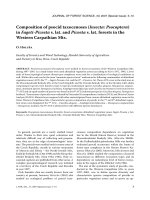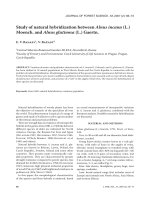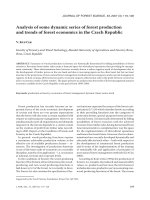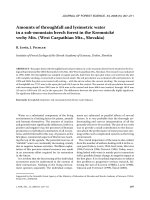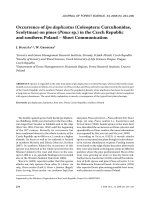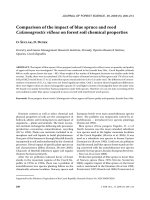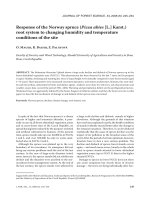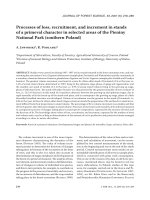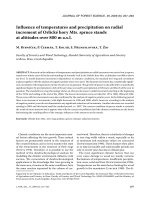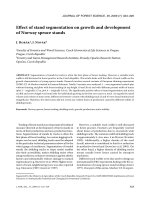Báo cáo lâm nghiệp: "Evaluation of physiological and health state of Norway spruce plants with different growth rate at juvenile stage after outplanting at" pdf
Bạn đang xem bản rút gọn của tài liệu. Xem và tải ngay bản đầy đủ của tài liệu tại đây (359.73 KB, 8 trang )
170 J. FOR. SCI., 57, 2011 (4): 170–177
JOURNAL OF FOREST SCIENCE, 57, 2011 (4): 170–177
Evaluation of physiological and health state of Norway
spruce plants with diff erent growth rate at juvenile stage
after outplanting at mountain locations
A. J, J. L, J. M
Opočno Research Station, Forestry and Game Management Research Institute,
Opočno, Czech Republic
ABSTRACT: Norway spruce (Picea abies [L.] Karst.) seedlings grown from seed originating from high mountain
locations (8
th
forest altitudinal zone – Norway spruce vegetation zone 1,000–1,250 m a.s.l.) show higher growth vari-
ability than seedlings from populations adapted to more favorable conditions at a lower altitude a.s.l. Seedlings smaller
than 8 cm in height were usually culled during sorting before transplanting (in common nursery practice) regardless
of the fact whether it was not planting material from high mountain locations. This paper presents the results of the
physiological and health state of 16 year old spruce stands established by outplanting of specifically sorted planting
material (comprising also slowly growing seedlings) on the research plot Pláň (Krkonoše Mts). Differences among vari-
ants in water losses during drying were relatively small and statistically insignificant due to high individual variability;
nevertheless, they indicate a certain positive trend in plants with slower growth dynamics in the nursery. Differences
in chlorophyll fluorescence among the variants were statistically significant. The trend of higher frost hardiness in
the “small” variant was obvious again. The health status results document the initial assumption of very good adapta-
tion to adverse mountain conditions in trees grown from seedlings characterized by slow growth in a nursery. The
results of evaluation of physiological parameters and health status confirm a hypothesis that plants with the initial
slow growth are a stable component of the population spectrum of mountain spruce trees. The results document good
preconditions for the establishment of vital and stable stands when the entire growth spectrum of planting stock and
particularly of plants produced from originally slow-growing seedlings is utilized.
Keywords: health status; mountain locality; Norway spruce; physiological trait
Supported by the Ministry of Agricuture of the Czech Republic, Project No. QH92062.
Norway spruce (Picea abies [L.] Karst.) seedlings
grown from seed originating from high mountain
locations (8
th
forest altitudinal zone) show higher
growth variability than seedlings from populations
adapted to more favourable conditions at a lower
altitude above sea level. Former legislation, which
was still in force in the Czech Republic in the nine-
ties of the last century (Departmental Standard
ON 48 2211 1989), recognized as spruce standard
seedlings plants of minimum shoot height 8 cm
while nonstandard seedlings could be used only
in valuable species and ecotypes of woody plants.
Seedlings more than 10 cm in height were recom-
mended for mechanized transplanting. It means
that in forest nurseries seedlings smaller than 8 cm
in height were usually culled during sorting before
transplanting. is practice may cause the narrow-
ing of the genetic spectrum, because was not use
part of populations from high mountain locations
for reforestation.
Seedlings with slow growth at a juvenile stage ap-
parently represent a very valuable part of mountain
populations with the best adaptation to extreme
environmental conditions. ey are probably in-
dividuals capable to survive extreme climatic fl uc-
tuations that may occur once over several tens
of years (L 1989). is statement is also sup-
ported by the fact that the shoot height of spruce
seedlings decreases with the increasing altitude of
their origin (M 1995; K 1998). It
J. FOR. SCI., 57, 2011 (4): 170–177 171
is assumed that in the process of adaptation to ad-
verse conditions of the mountain environment the
spruce populations acquire higher resistance at the
expense of growth rate at a juvenile stage, i.e. in the
fi rst several years of age.
e deterioration of the condition of some young
forest outplantings currently arouses a question
whether sorting in a forest nursery did not cause
the undesirable narrowing of the genetic spectrum
of mountain spruce populations when individu-
als with the best adaptability to extreme mountain
conditions were culled. erefore detailed investi-
gations of morphological, physiological and genetic
traits of young spruces with known growth rate in
a nursery and after outplanting are carried out in
the framework of the grant project “Conservation
of the stability and biodiversity of Norway spruce
mountain populations”. is paper presents the re-
sults of the health and physiological state of young
spruce stands established by outplanting of spe-
cifi cally sorted planting material (comprising also
slowly growing seedlings) on the Pláň research plot
monitored in the long run in a model mountain
area of the Krkonoše Mts.
MATERIAL AND METHODS
e research plot “Pláň” was established in 1994
on the northern slope of the Stoh ridge in the
Krkonoše Mts. (forest stand group 73, forest site
type group 8K, altitude 1,000–1,100 m a.s.l., clear-
cut area ca 2ha in size). One of the objectives was
to investigate the infl uence of specifi c sorting in a
forest nursery on the growth and stability of out-
plantings of Norway spruce mountain populations.
Plants grown from specifi cally sorted seedlings
were outplanted. In 1992, before transplanting,
two-year seedlings originating from the 8
th
for-
est altitudinal zone (FAZ) (designation of origin:
B/SM/0001/22/8/TU) were divided into 3 size cat-
egories: smaller than 8 cm (the “small” variant),
8 to 15 cm (“intermediate medium”) and 16 to 22
cm (“large”). e plants were cultivated under stan-
dard procedure for bare-rooted planting stock after
sorting. e four-year plants (2 + 2) were set onto
a mountain clearcut area. Each variant comprised
3 replications by 100 plants. In the proximity of re-
search plot a part of the even-aged forest outplant-
ing was demarcated as the control comparative
material (planting stocks from common nursery
practice). Height and diameter growth and health
status of outplantings are evaluated regularly on
this research plot. A more detailed evaluation of
phenology and physiological state was done in
spring 2009 and 2010.
Physiological characteristics (chlorophyll fl uo-
rescence, frost hardiness, resistance to desiccation)
were determined in a laboratory of the Research Sta-
tion in Opočno (Opočno RS). After plants transport
to the laboratory, branch samples collected on 26
May 2009 on the Pláň research plot were put into
water dipping their bases and covered by polyethyl-
ene sheet in order to ensure the water imbibition of
branches in a moist environment. On the next day,
annual shoots were gradually clipped off , weighed
immediately and subsequently subjected to con-
trolled desiccation in laboratory conditions. Wa-
ter losses were determined after 15 minutes when
mainly stomatal transpiration took place, then after
60, 180 and 240 minutes when water losses were
caused mainly by cuticular transpiration. When the
evaluation of water losses terminated, samples were
dried at 80°C to constant weight and their dry matter
and initial water content were determined. Fifteen
branch samples from each variant were evaluated.
Other parts of branches were used to measure
chlorophyll fl uorescence and frost hardiness. Sepa-
rate needles were severed from annual shoots, stuck
on an adhesive tape on a pad and dark-adapted in
a moist chamber at a laboratory temperature for
45 min at least. e basic characteristics of chlo-
rophyll fl uorescence and photosynthetic electron
transport rate (ETR) were measured at increasing
light intensity with an Imaging-PAM 2000 device
(Heinz Walz GmbH, Eff eltrrich, Germany). Mea-
suring light of the intensity 3 µmol·m
–2
·s
–1
and sat-
uration impulse of the intensity 2,400 µmol·m
–2
·s
–1
for 800 ms were applied for measurements. e
basic measured characteristic of chlorophyll fl uo-
rescence was the maximum quantum yield of pho-
tosystem II photochemistry (F
v
/F
m
) calculated as
the ratio of variable (F
v
) to maximum (F
m
) fl uores-
cence. Variable fl uorescence was obtained from a
diff erence between the basic fl uorescence of dark-
adapted needles (F
0
) and maximum fl uorescence
(F
m
) after the radiation of a sample with an impulse
of saturation light. e maximum quantum yield of
photochemistry was computed from the formula
F
v
/F
m
= (F
m
– F
0
)/F
m
.
e remaining parts of twigs, from which a part
of needles was severed, were put into polyethylene
bags and subjected in a freezing box to a tempera-
ture of –20°C for 20 hours. After tempering to room
temperature another measurement of chlorophyll
fl uorescence followed to determine the extent of
damage caused by a freezing test. 15 samples from
each variant were evaluated.
172 J. FOR. SCI., 57, 2011 (4): 170–177
Bud break was evaluated once in the spring season
(all buds) by the scale shown in Table 1. e evalua-
tion comprised 70 to 100 spruces from each variant.
Health status was evaluated in autumn according
to foliage percentage and frequency of occurrence
of damage to stems and branches (injuries, break-
ages, deformations) in 70 to 100 spruces from each
variant (Table 2). Foliage was evaluated visually to
the nearest tens of percent.
Data from fi eld and laboratory measurements
were processed and statistically evaluated by the
Excel and QC Expert software. Analysis of variance
(two factors ANOVA) was used to test the diff er-
ences due to height categories and freezing test
on characteristic of chlorophyll fl uorescence. e
confi dence interval at a 5% signifi cance level is used
for the representation of statistical signifi cance in
graphs.
RESULTS
Water losses during controlled desiccation
Water losses were determined in the course of
desiccation of severed spruce annual shoots im-
bibed with water in laboratory conditions (21
±1°C, relative air humidity 50 ± 5%). Fig. 1 illus-
trates water content expressed in percent of the ini-
tial water content after 15 and 180 min of exposure.
e graph shows the highest losses in spruces of
the “large” variant, followed by “medium” variant
and the smallest losses were in the “small” variant,
during stomatal (the fi rst 15 min) and cuticular
(180 min) transpiration. Diff erences among vari-
ants were relatively small and statistically insignifi -
cant due to high individual variability; neverthe-
less, they indicate a certain positive trend in plants
with slower growth dynamics in the nursery.
Chlorophyll fl uorescence
Fig. 2 documents the variable to maximum fl uores-
cence (F
v
/F
m
) ratio determined after the irradiation
of a dark-adapted needle sample that represents the
maximum quantum yield of photosystem II (PSII)
photochemistry. It is documented in literature that
the values of this characteristic in undamaged leaves
of trees of the temperate zone are usually higher than
0.75. Hence all evaluated variants in fresh condition
(before a freezing test) showed good condition and
functionality of the assimilatory apparatus.
e exposure to freezing temperatures (–20°C for
20 h) caused partial damage to photosystem II, which
resulted in a decrease in the F
v
/F
m
value. e most
pronounced damage was found out in the “large”
variant while the “small” variant showed the small-
est damage (Fig. 2). e values of spruces from the
“medium” variant were between those of the other
two variants. e trend is the same as in water losses
when the highest resistance was observed in plants
from the “small” variant and the lowest resistance
was in the “large” variant. Diff erences in chlorophyll
fl uorescence among the variants were statistically
signifi cant (Table 3). e trend of higher frost hardi-
ness in the “small” variant was obvious again.
Table 1. e scale for phenological evaluation of young
spruces
Degree of
bud break
Bud state
0 dormant, buds are not swollen
1 swollen buds, translucent green needles
2
burst buds, needles begin to emerge from
fascicles
3 emerged needles
4 beginning of shoot elongation growth
5
intensive elongation growth of young
shoots
Table 2. Indexes for the evaluation of damage to spruce stem and branches
Type of damage Description of damage Index
Stem damage
no damage
substitute shoots
stem breakages
0
1
2
Branch damage
no damage
moderate damage (small injuries, breakages of weak branches)
medium damage (larger injuries, damage to thicker branches)
great damage (tree stability is disturbed, deep injuries of stem)
total crown devastation
0
1
2
3
4
J. FOR. SCI., 57, 2011 (4): 170–177 173
Fig. 1. Water losses (in % of the initial water content)
after 15 and 180 min of desiccation. e whiskers show
the confi dence interval at a 5% signifi cance level
Reaction of the assimilatory apparatus
to increasing radiation intensity
At the increasing intensity of photosynthetically
active radiation (PAR) it was evaluated the photo-
synthetic electron transport rate (ETR) indicating
the speed of transport of electrons from photosys-
tem II (PSII) and their utilization for further pro-
cesses of photosynthesis.
In this characteristic very similar values were re-
corded in all three evaluated variants of fresh, un-
frozen needle samples (Fig. 3). In samples subject-
ed to a freezing test (–20°C for 20 h) pronounced
disturbance of PSII photochemistry occurred,
which resulted in a decrease in the values of ETR
in the entire course of curves, i.e. at all intensities
of photosynthetically active radiation. e lowest
decrease was observed in the “small” variant and
the highest decrease in the “large” variant. If the
experimental variants were compared, also in this
case the trend was identical to that of the other
above-mentioned characteristics.
Bud break
e evaluation of buds break in spring 2010
are presented in Fig. 4. e frequency of spruces
showed diff erent degrees of bud break (the evalua-
tion is described in the chapter Method). e high-
est proportion of later fl ushing trees was observed
in the “small” variant.
Health status
e health status and frequency of spruce damage
in the particular research variants were evaluated
on Pláň research plot in the autumn season. Fig. 5
illustrates the average foliage percentage. Spruces
grown from the smallest seedlings (“small” variant)
that would be culled during standard sorting had
the best foliage. e poorest foliage was observed
on control plots in forest outplantings.
Damage to branches and stem was evaluated ac-
cording to severity. Damage indexes are shown in
Table 2 in the chapter Material and Methods.
e frequency of stem damage occurrence is il-
lustrated in Fig. 6 and the frequency of branch
damage occurrence is shown in Fig. 7. ese results
also document the very good condition of variants
grown from the smallest seedlings (small). e
most frequent damage was observed on the control
plot in a forest outplanting.
e above results also document the initial as-
sumption of very good adaptation to adverse
Fig. 2. Maximum quantum yield of chlorophyll
fl uorescence (F
v
/F
m
) in fresh samples of spruce
needles and after their exposure to freezing tem-
peratures. e whiskers show the confi dence
interval at a 5% signifi cance level
88.0
15 minutes 180 minutes
15 min 180 min
100.0
98.0
96.0
94.0
92.0
90.0
88.0
86.0
84.0
(%)
■ small
▩ medium
□ large
0.400
0.500
0.600
0.700
0.800
0.900
0.000
0.100
0.200
0.300
fresh frozen
■ small
▩ medium
□ large
Fresh Frozen
0.900
0.800
0.700
0.600
0.500
0.400
0.300
0.200
0.100
0.000
F
v
/F
m
174 J. FOR. SCI., 57, 2011 (4): 170–177
mountain conditions in trees grown from seedlings
characterized by slow growth in a nursery.
DISCUSSION
e overall evaluation of the physiological state
of young spruces grown from seedlings with dif-
ferent growth rate in a forest nursery and planted
to an extreme mountain clearcut area showed the
highest water losses during controlled desiccation
in laboratory conditions in spruces grown from
the fastest growing seedlings (“large” variant).
ey were followed by spruces grown from me-
diocre seedlings (“medium” variant) and the low-
est water losses were observed in spruces grown
from small, slow-growing seedlings that would be
culled by standard sorting (“small” variant). is
trend was identical in the fi rst 15 minutes (mostly
stomatal transpiration) and also after 180 minutes
(mostly cuticular transpiration). Even though dif-
ferences in the results were not signifi cant because
of high individual variability, they document good
water “management” in the variant grown from
slower-growing seedlings. e values of the maxi-
mum quantum yield of fl uorescence (F
v
/F
m
) in
fresh samples hardly diff ered among the variants.
ey all indicated good condition and functional-
ity of the assimilatory apparatus. After the expo-
sure of branch samples to freezing temperatures
the highest damage to the assimilatory apparatus
(the highest drop in the values of F
v
/F
m
ratio) was
found out in spruces of the “large” variant, followed
by spruces of the “medium” variant and the small-
est damage was observed in spruces of the “small”
variant. is test also documents higher resistance
to stresses in outplantings originating from slower-
growing seedlings. e evaluation of the photosyn-
thetic electron transport rate (ETR) at increasing
radiation intensity showed a similar trend among
the variants in samples in fresh condition and dam-
age caused by freezing test increasing from “small”
to “large” variants.
e observed diff erences among variants in all
studied physiological characteristics were relatively
small and statistically insignifi cant due to the high
individual variability of trees. Nevertheless, these
are important fi ndings confi rming an assumption
that seedlings with slow juvenile growth represent
a very valuable part of mountain spruce popula-
tions that should not be culled in nurseries.
Mountain populations of Norway spruce (Picea
abies [L.] Karst.) show higher variability of seed
and seedlings compared to spruce from lower lo-
Table 3. Analysis of variance for values of chlorophyll fl uorescence (F
v
/F
m
) on research plot Pláň
Source of variance
Sums of
squares
Mean
squares
Degrees of
freedom
Standard
deviation
F-exp. F-test
Height categories 0.312 0.156 2 0.3952 9.4661 3.0300 Signifi cant
Fresh/frozen 1.170 1.170 1 1.0816 70.9190 3.8769 Signifi cant
Interaction 0.505 0.253 2 0.5027 15.3213 3.0300 Signifi cant
Residue 4.355 0.016 264.000 0.128
Sum 6.964 0.026 269.000 0.161
small
medium
large
10.0
1 2 3 4 5 6
Fig. 4. Proportions of spruces with diff erent degrees of bud
break on the date of evaluation 1
st
June 2010 (a description of
the particular degrees of bud break see Table 1
Fig. 3. Photosynthetic electron transport rate (ETR) at in-
creasing radiation (PAR) intensity
fresh small
fresh medium
0 500 1,000 1,500
fresh small
fresh medium
fresh large
frozen small
PAR (mol·m
–2
·s
–1
)
ETR (mol·m
–2
·s
–1
)
Frequency (%)
Degree of bud break
■ small
▩ medium
□ large
1 2 3 4 5 6
0 500 1,000 1,500
70
60
50
40
30
20
10
0
40.0
35.0
30.0
25.0
20.0
15.0
10.0
5.0
0.0.
J. FOR. SCI., 57, 2011 (4): 170–177 175
cations (K 1998). Diff erences in growth
rate and dynamics also exist in seedlings grown in
constant conditions (H 1984; H et al.
1987). Diff erences in growth among spruce popula-
tions originating from diff erent altitudes and grown
in the same environment are most pronounced in
the fi rst years of seedling life (H 1984; Q-
et al. 1995). e lower growth rate of
spruce mountain populations is assumed to be con-
nected with their increased adaptation to adverse
mountainous conditions (O et al. 1998).
Other authors have also documented the relation-
ship between growth and vulnerability to adverse
eff ects. B (2000) determined, on the basis
of chlorophyll fl uorescence measurements, higher
vulnerability to the eff ect of elevated temperatures
in fast-growing seedlings of Picea glauca compared
to slow-growing ones. Below-average growth in
young trees of Norway spruce with high tolerance
to SO
2
was reported by W (2001).
Higher frost hardiness in spruce populations
originating from higher elevations or from more
northern areas, compared to seedlings from low-
er locations or of more southern provenance, was
described by S (1994), H and S-
(2000), W et al. (2000) and S
(2008), while better drought resistance in these
populations was reported by M and
E (2002). In two-month spruce seedlings
of an ecotype adapted to higher altitude V et
al. (2008) found out a lower level of thermotoler-
ance and a higher level of tolerance to oxidative
stress compared to seedlings of an ecotype from
lower altitude.
e hypothesis of the relationship between adapt-
ability to adverse infl uences and growth rate of
spruce was confi rmed by our results demonstrating
good drought resistance and frost hardiness in plants
grown from originally slow-growing seedlings. Af-
ter outplanting to extreme mountainous conditions
the markedly better health status and higher growth
rate were observed in the planting stock grown
from “small” (slow-growing) seedlings than in origi-
nally fast-growing plants. e foliage percentage
was highest in the originally small plants (J,
M 1996, 2001). Detailed evaluation con-
fi rmed their good physiological predispositions to
resist adverse infl uences and climatic extremes oc-
curring in mountain areas in longer time intervals.
It agrees with conclusions of B and V
(2009) that fast growth and larger size may appear
as an advantage from the aspect of higher competi-
tiveness and enhancement of short-term chances of
plant establishment. However, fast growth and large
size imply lower investments in defence, lower wood
density and mechanical strength, which may lead to
a decrease in longevity.
Diff erent criteria of the sorting of seedlings and
plants should be used in the production of planting
stock for higher mountainous locations because the
85
90
95
100
Foliage (%)
75
80
85
90
95
100
small
medium
large
control
Foliage (%)
Fig. 5. Average foliage percentage in spruces on research
plot Pláň. e whiskers show the confi dence interval at a
5% signifi cance level
Fig. 6. Frequency of stem damage occurrence in
the particular variants of spruce on research plot
Pláň (a description of the particular degrees of bud
break see Table 2)
∎ – stem damage index 0
∎ – stem damage index 1
∎ – stem damage index 2
20.00%
small medium large control
Treatment
small medium large control
Treatment
100
90
80
70
60
50
40
30
20
10
0
(%)
Small Medium Large Control
100
95
90
85
80
75
Foliage (%)
176 J. FOR. SCI., 57, 2011 (4): 170–177
culling of smaller, slow-growing plants may cause
the narrowing of the genetic spectrum and dis-
carding of just those plants that are best adapted to
growth in extreme mountainous conditions (H-
et al. 1987; L 1989; J, M
1996, 2001). Neither did K (1998) consider
as desirable the sorting out of small spruce plants
and their culling or planting separately onto diff er-
ent plots because it may cause the pronounced nar-
rowing of the genetic structure of progenies. But it
should be defi ned precisely what seedlings are the
real cull and in what seedlings slow growth may be
connected with favourable genetic endowment for
extreme conditions.
is latest knowledge has already been embodied
in current legislation of the Czech Republic and in the
Czech technical standard in force (ČSN 48 2115 1998)
in which the size of seedlings used for transplanting
or planting into containers is not defi ned any more. In
plantable planting stock the current standard ČSN 48
2115 takes into account specifi cities of the growth of
Norway spruce mountain populations while it is pos-
sible to increase the maximum age of planting stock
from the 8
th
and 9
th
forest altitudinal zone by 1 year
and the shoot height is not considered as the main
morphological traits of quality.
CONCLUSION
e experiments demonstrated that the relative-
ly small diff erences in physiological parameters,
which were observed among the variants, mark-
edly infl uenced the health status of trees after 16
years of growth on an extreme mountainous clear-
cut area. e results of evaluation of physiological
parameters and health status confi rm a hypothesis
that plants with the initial slow growth are a stable
component of the population spectrum of moun-
tain spruce trees. e results document good pre-
conditions for the establishment of vital and stable
stands when the entire growth spectrum of plant-
ing stock and particularly of plants produced from
originally slow-growing seedlings is utilized.
Knowledge of the growth of Norway spruce
mountain populations documents that the growth
dynamics of a part of the population with increased
resistance to stress factors is manifested more pro-
nouncedly in the second decennium after outplant-
ing onto extreme mountain sites.
is is the reason why it will be useful and neces-
sary to study and evaluate all other experimental
plantings of Norway spruce in longer time series
after outplanting.
R e fe r en c es
B C., V T.T. (2009): Increased early growth
rates decrease longevities of conifers in subalpine forests.
Journal Oikos, 118: 1130–1138.
B F.J. (2000): Selection of white spruce families in the
context of climate change: heat tolerance. Tree Physiology,
20: 1227–1234.
ČSN 482115 (1998): Planting stock of forest tree species.
Czech Technical Standard. Praha, ČNI: 17. (in Czech)
H C.D.B., S K.B. (2000): Frost hardiness,
height, and dormancy of 15 short-day, nursery-treated
interior spruce seed lots. Canadian Journal of Forest Re-
search, 30: 1096–1105.
H K. (1984): Die Bedeutung der Genetik für den Hoch-
lagenwaldbau. In: Establishment and Tending of Subalpine
Forest. Proceedings of 3
rd
IUFRO Workshop. Gottingen,
21.–24. August 1984. Wien, Eidgennössische Anstalt für
das Forstliche Versuchswesen: 225–232.
H K., S U., P V., M F. (1987):
Stand und Problematik der Fichten – Stecklingsver-
mehrung. Österreichische Fortzeitung, 98: 12–13.
J A., M J. 1996): Acclimation and specifi c
growth of planting stock of mountain spruce. In: V
S. (ed.): Proceedings of Monitoring, Research and Man-
agement of Ecosystems in the Krkonose National Park
10%
Fig. 7. Frequency of branch damage
occurrence in the particular variants of
spruce on research plot Pláň (a descrip-
tion of the particular degrees of bud
break see Table 2 in the chapter Method)
∎ – branch damage index 0
∎ – branch damage index 1
□ – branch damage index 2
▩ – branch damage index 3
∎ – branch damage index 4
small medium large control
Treatment
100
90
80
70
60
50
40
30
20
10
0
(%)
J. FOR. SCI., 57, 2011 (4): 170–177 177
Region. Opočno, 15.–17. April 1996. Opočno, VÚLHM:
133–141. (in Czech)
J A., M J. 2001): Infl uence of altitude of
nursery, containerised technology and sorting intensity on
performance of spruce (Picea abies [L.] Karsten) from high
altitude seed sources after outplanting. In: Proceeding of
the International Conference Geoecological Problems in
the Giant Mountains, Krkonoše National Park. Svoboda
nad Úpou, 19.–21. September 2000. Vrchlabí, KRNAP
Administration: 608–615. (in Czech)
K P. (1998): Restoration a reproduction genetic sources
autochthonous populations from the 8
th
forest vegetation
zone in Hruby Jesenik and Kralicky Sneznik. [Ph.D. esis.]
Brno, MZLU: 139. (in Czech)
L H. P. (1989): Risks arising from the reduction of genetic
variability of some Alpine Norway spruce provenances by
size grading. Forestry Supplement, 62: 49–52.
M J. (1995): Altitudinal adaptation of Norway
spruce (Picea abies [L.] Karst.) progenies indicates small
role of introduced populations in the Karkonosze moun-
tains. Silvae Genetica, 44, 70–75.
M J., E G. (2002): Response of Picea
abies populations from elevational transects in the Polish
Sudety and Carpathian mountains to simulated drought
stress. Forest Ecology and Management, 165: 105–116.
O J., M J., T M.G., Z
R., R P.B., K P. (1998): Growth physiol-
ogy of Picea abies populations from elevational transects:
common garden evidence for altitudinal ecotypes and cold
adaptation. Functional Ecology, 12: 573–590.
ON 48 2211 (1989): Seedlings and Plants of Forest Tree Spe-
cies. Departmental standard. Praha, ÚNM: 18. (in Czech)
Q M., E I., D I., N L.,
C D., E G. (1995): Early eff ects of long
nights on budset, bud dormancy and abscisic acid con-
tent in two populations of Picea abies. Forest Genetics,
2: 207–216.
S G. (2008): Dormancy and frost hardiness in Nor-
way spruce seedlings. [Ph.D. esis.] Aas, e Norwegian
University of Life Sciences: 42.
S D.G. (1994): Seasonal and geographic origin eff ects
on cold hardiness of white spruce buds, foliage, and stems.
Canadian Journal of Forest Research, 24: 1066–1070.
V C.M., L C., P C., S K. (2008):
Heat induced changes in protein expression profi les of
Norway spruce (Picea abies) ecotypes from diff erent eleva-
tions. Journal Proteomics, 8: 4287–4302.
W J., S L.G., S M., H J.E.
(2000): Phenotypic differences between natural and
selected populations of Picea abies. I. Frost hardiness.
Scandinavian. Journal of Forest Research, 15: 489–499.
W H. (2001): Eff ects of extreme SO
2
–
air pollution in
winter 1995/96 on vitality and growth of SO
2
–
tolerant
Norway spruce (Picea abies [L.] Karst.) clones in the Ore
mountains. In: M-S G., S R. (eds):
Genetic response of forest systems to changing environ-
mental conditions. Proceedings of the IUFRO Division 7
(Forest Health) and Division 2 (Physiology & Genetics)
conference. Freising/Münich, 1.–3. October 2001. Wien,
IUFRO: 35–49.
Received for publication October 8, 2010
Accepted after corrections December 20, 2010
Corresponding author:
Ing. J L, Forestry and Game Management Research Institute, Opočno Research Station,
Na Olivě 550, 517 73 Opočno, Czech Republic
e-mail:
